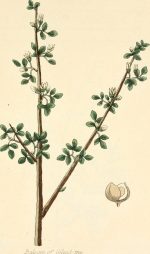 This evergreen shrub or small tree is found in Saudi Arabia, Yemen, southern Oman, Sudan and in southeast Egypt and is a member of the torchwood family, Burseraceae, that also includes fankincense and myrrh. It is also known as Balm of Gilead but shares that common name with several other plants. Plants may be shrubs or trees, erect or prostrate, depending on the site and may grow up to 12′ tall with spreading branches. The leaves are pinately compound with 3-5 oblong leaflets .2-1.5″ long. In summer small male and female flowers are produced singly or in small clusters of 2-5 on short side shoots along the banches of different plants. The male flowers are cream colored at first but quickly change to yellow then red, attracting bees, ants and other pollinators. The fertilized female flowers give way to dull red one seeded edible fruits with 4 longitudinal white strips. The plants are valued for their sap, bark, wood and seeds and have been used since ancient times for perfume and medicinal compounds. The bark is cut to allow the sap to run out and dry for use as incense. The genus name Commiphora, comes from the Greek kommi meaning gum and phoros meaning bearing and refers to the resin. The specific epithet, gileadensis, honors Gilead, the the mountainous area east of the Jordan River,rernowned for its balm.
This evergreen shrub or small tree is found in Saudi Arabia, Yemen, southern Oman, Sudan and in southeast Egypt and is a member of the torchwood family, Burseraceae, that also includes fankincense and myrrh. It is also known as Balm of Gilead but shares that common name with several other plants. Plants may be shrubs or trees, erect or prostrate, depending on the site and may grow up to 12′ tall with spreading branches. The leaves are pinately compound with 3-5 oblong leaflets .2-1.5″ long. In summer small male and female flowers are produced singly or in small clusters of 2-5 on short side shoots along the banches of different plants. The male flowers are cream colored at first but quickly change to yellow then red, attracting bees, ants and other pollinators. The fertilized female flowers give way to dull red one seeded edible fruits with 4 longitudinal white strips. The plants are valued for their sap, bark, wood and seeds and have been used since ancient times for perfume and medicinal compounds. The bark is cut to allow the sap to run out and dry for use as incense. The genus name Commiphora, comes from the Greek kommi meaning gum and phoros meaning bearing and refers to the resin. The specific epithet, gileadensis, honors Gilead, the the mountainous area east of the Jordan River,rernowned for its balm.
Type: Evergreen shrub (but may drop leaves after blooming)
Outstanding Feature: Perfume and medicinal qualities
Form: Rounded
Growth Rate: Slow
Bloom: Small red flowers carried on short stalks singly or in clusters of 2-5
Size: 1-12′ H
Light:Full sun
Soil: Average, medium moist to dry, well-drained
Hardiness: Zones 10-11
Care: Low maintenance
Pests and Diseases: None of significance
Propagation: Seed
Photo Credit: Wikipedia